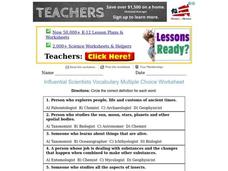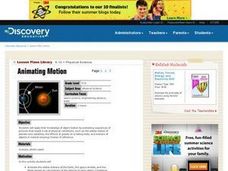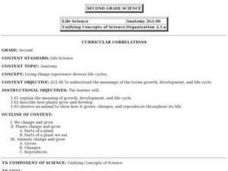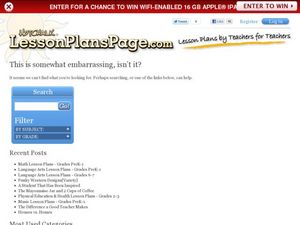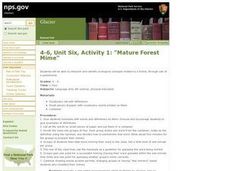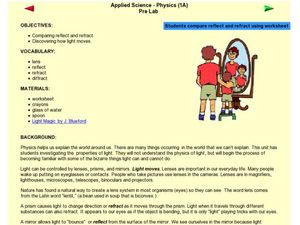Curated OER
Influential Scientists Vocabulary Multiple Choice Worksheet
In this influential scientists activity, learners read the definitions of 19 science professions. From 4 choices, students choose the correct name of the job that fits the definition. Example: studies birds (ornithologist).
Curated OER
Hero Or Zero?
Learners investigate science and technology by reading a children's book. In this reading comprehension lesson, students read the story Archibald Frisby and discuss the ways we use science and technology in everyday life....
Cornell University
Splitting Water with Electricity
Explore how electricity splits water molecules into hydrogen and oxygen. Learners begin by calculating the voltage necessary to separate the water. They then perform the experiment and measure the ratio of hydrogen and oxygen bubbles.
Curated OER
Beaver Ecology
Students explore the lives of bgeahvers. They identify the physical and behavioral adaptations that help beavers survive in their environment. Students compare and contrast how beavers influence the ecology of both forest and aquatic...
Curated OER
Archimedes' Principle
Students examine the relationship between density and buoyancy. In this physics instructional activity students use Archimedes' Principle to complete calculations on buoyancy and a lab activity.
Curated OER
Exploring Limu Diversity
Students explore limu diversity. In this ocean ecosystem lesson, students classify limu according to its physical properties. Students work in small groups to generate scientific observations and sort limu by characteristics.
LABScI
Taxonomy: Who is in My family?
Find similarities in seemingly unlike organisms. The second instructional activity in a series of 12 builds the concept of a taxonomy and explores the use of a dichotomous key. Learners begin in part one by attempting to group a set of...
American Museum of Natural History
Beyond T. Rex
Some dinosaurs get all the attention. Pupils use an interactive resource to study some of the lesser-known dinosaur species. Organizing the information in a cladogram allows learners to make connections among the species.
Curated OER
Describing Nests
Students observe bird nests. In this observation level, students explore bird nests using their five senses. Students compare and contrast bird nests while hypothesizing about the need birds have to construct the nest.
Curated OER
Grating Spectrometer
Students calculate the Balmer series. In this physics lesson, students observe hydrogen lamp spectra using spectrometers. They calculate wavelength and compare them with their theoretical calculations.
Curated OER
Animating Motion
Students apply what they recall about objects in motion by animati ng sequences of pictures that model a set of physical conditions. They animate the orbital motions of the Earth, the space shuttle, and the Moon based on calculations of...
Curated OER
Living Things Experience Diverse Life Cycles
Second graders will study and explain the meaning of growth, development, and life cycle. They describe how plants grow and develop and observe an animal to show how it grows, changes, and reproduces throughout its life.
Curated OER
Probability: The Study of Chance
Students conduct an experiment, determine if a game is fair, and collect data. They interpret data, then display line graph. They conduct analysis of game for probability.
Curated OER
Design a Reef!
Here is an ambitious, but highly valuable undertaking: set up a miniature coral reef in your classroom. Young marine scientists research coral reef ecosystems and ensure all vital factors are included in their functioning model. The...
Curated OER
Forest Communities
Students identify tree specimens. In this tree specimens lesson, students collect different parts of a tree from the areas around the school or their home. They then work in groups to create booklet that identifies tree...
Curated OER
Mature Forest Mime
Learners come to understand vocabulary words through pantomime. For this vocabulary lesson, students first review several vocabulary words and their meaning, then they work in groups to pantomime the definitions.
Curated OER
More about Arteries, Veins and Capillaries
Students list and describe the purpose/function of blood vessels (arteries, veins and capillaries). They explain how blood flows through the body, and the role of physical activity and how it strengthens the heart.
Curated OER
Tree Cookie Combat
Fourth graders discover what trees need to live and grow in the environment. They realize that trees sometimes interact or compete with other organisms as well as each other. They identify the physical characteristics of Utah's...
Curated OER
Exterior Ballistics
Students explore velocity and trajectory. Using exterior ballistics rules, students predetermine the path of an artillery shell. Given equations and the firing angle, students determine the velocity and horizontal travel. Students...
Curated OER
Measure Up!
Students examine parallax and angular measurements. In this investigative lesson students calculate distances of objects and map their results.
Curated OER
Reflect and Refract
Young scholars explore light. For this properties of light lesson, students define the terms refract, reflect, and diffract after listening to the teacher's description. Young scholars listen to the book Light Magic and observe a spoon...
Curated OER
Classification
In this classification worksheet, students will look at how biological classification began and how scientific names are used in biology. Students will use a table showing the classification of four organisms to answer 10 short answer...
Curated OER
Soil Formation
For this soil formation worksheet, learners will review examples of chemical weathering and biological weathering. Students will also review the different soil layers and how they are created. This worksheet has 6 matching, 5 multiple...
Curated OER
Ecology
In this ecology worksheet, students read information about ecology and the nine ecology subdivisions and answer comprehension questions. Students answer ten questions in this matching and fill in the blank worksheet.
